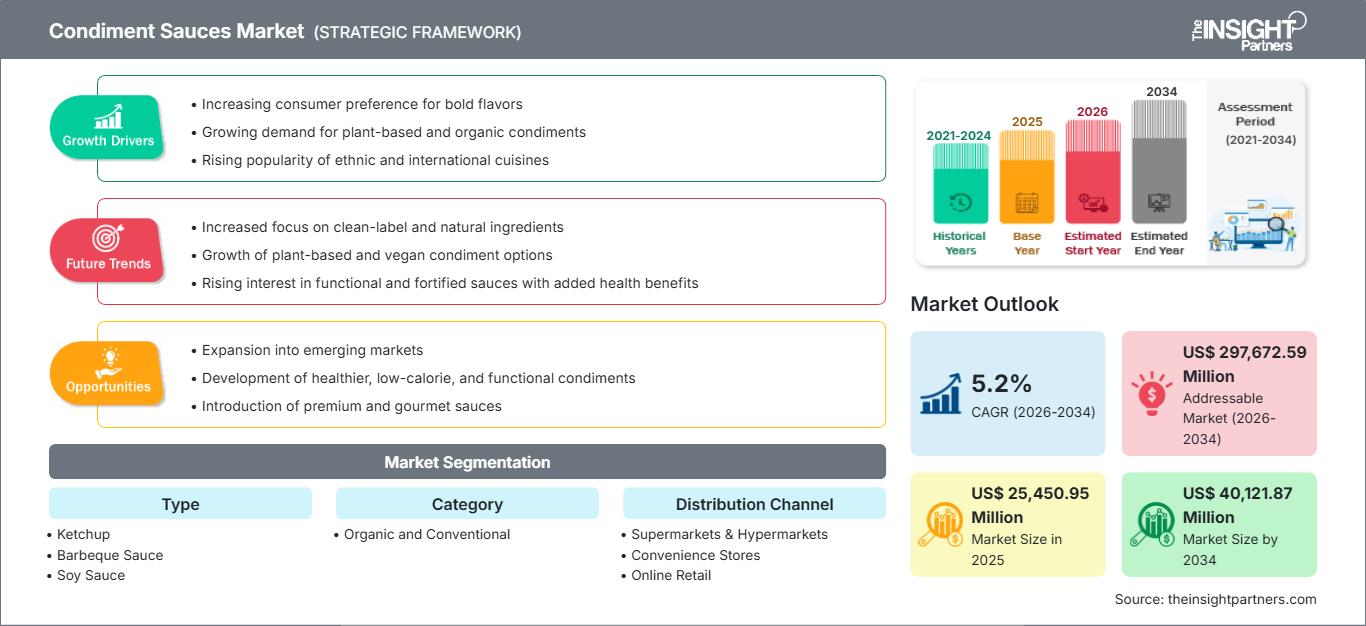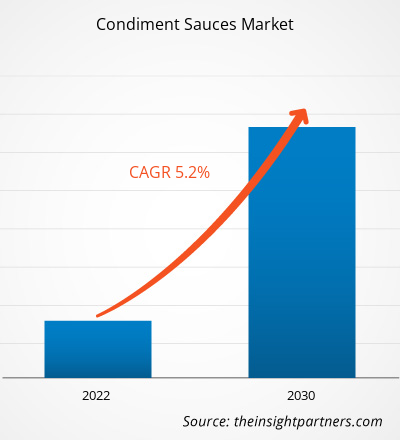Se proyecta que el mercado de salsas para condimentos, valorado en US$ 25.450,95 millones en 2025, alcance los US$ 40.121,87 millones para 2034, con una tasa de crecimiento anual compuesta (TCAC) del 5,2 % durante el período 2026-2034. Las condiciones del mercado siguen evolucionando, lo que genera nuevas oportunidades para los interesados. El panorama general refleja un progreso estable y un potencial de crecimiento a largo plazo.
Factores impulsores del crecimiento y desafíos:
Los consumidores de todo el mundo disfrutan cada vez más de la variedad de sabores de la cocina internacional, desde la asiática, la de Oriente Medio y la latinoamericana hasta la africana. Además, el auge del turismo gastronómico y la popularidad de los programas de cocina contribuyen al deseo de los consumidores de replicar sabores diversos y sofisticados en casa. Se espera que este factor impulse nuevas tendencias en el mercado de las salsas para condimentos. Asimismo, blogueros gastronómicos, influencers y comunidades online comparten recetas, técnicas de cocina y recomendaciones de salsas para condimentos únicas en redes sociales y plataformas digitales. Este espacio virtual interconectado les permite descubrir y explorar numerosas opciones de salsas para condimentos, fomentando una cultura de experimentación e impulsando la demanda de sabores nuevos y emocionantes. Estos factores desempeñan un papel importante en la previsión del mercado de las salsas para condimentos.
Los consumidores disfrutan cada vez más de sabores diversos y globales. Esta curiosidad y la disposición a probar nuevas cocinas generan una demanda de opciones de salsas para condimentos prácticas y auténticas que realzan y personalizan el sabor de diversos platos y mejoran la experiencia culinaria. Los fabricantes también introducen variaciones exóticas de condimentos, como salsas especiales únicas inspiradas en diferentes tradiciones culinarias. Además, algunos productores introducen salsas artesanales, gourmet y de producción limitada, elaboradas con ingredientes naturales y de primera calidad, ofreciendo a los consumidores opciones de alta calidad que se adaptan a sus paladares más aventureros. Estos factores impulsan el crecimiento del mercado de las salsas para condimentos.
El aumento de los costos asociados con la búsqueda de proveedores alternativos, la aceleración de envíos o la gestión de desafíos imprevistos en la cadena de suministro fluctuan los precios de los productos. Estas fluctuaciones pueden representar un desafío para productores y consumidores, lo que podría afectar las decisiones de compra y la dinámica general del mercado.
Personalice este informe según sus necesidades
Recibirá personalización de cualquier informe, sin cargo, incluidas partes de este informe o análisis a nivel de país, paquete de datos de Excel, y además aprovechará grandes ofertas y descuentos para empresas emergentes y universidades.
Mercado de salsas para condimentos: Perspectivas estratégicas

-
Obtenga las principales tendencias clave del mercado de este informe.Esta muestra GRATUITA incluirá análisis de datos, desde tendencias del mercado hasta estimaciones y pronósticos.
Segmentación y alcance del informe:
El análisis del mercado de salsas para condimentos se ha llevado a cabo considerando los siguientes segmentos: tipo, categoría, canal de distribución y geografía. El mercado, por tipo, está segmentado en kétchup, salsa barbacoa, salsa de soja, salsa de mostaza, salsa de chile y otros. Según la categoría, el mercado se bifurca en orgánico y convencional. Según el canal de distribución, el mercado está segmentado en supermercados e hipermercados, tiendas de conveniencia, venta minorista en línea y otros. El mercado de salsas para condimentos, por geografía, está segmentado en América del Norte (EE. UU., Canadá y México), Europa (Alemania, Francia, Italia, Reino Unido, Rusia y el resto de Europa), Asia Pacífico (Australia, China, Japón, India, Corea del Sur y el resto de Asia Pacífico), Oriente Medio y África (Sudáfrica, Arabia Saudita, Emiratos Árabes Unidos y el resto de Oriente Medio y África), y América del Sur y Central (Brasil, Argentina y el resto de América del Sur y Central).
Análisis segmentario:
Según la categoría, el mercado de salsas para condimentos se divide en orgánico y convencional. El segmento convencional representa una participación significativa en el mercado global de salsas para condimentos. Sin embargo, se espera que el mercado del segmento orgánico crezca significativamente durante el período de pronóstico. Los consumidores están tomando conciencia sobre su salud y están cambiando sus hábitos alimenticios, priorizando productos que se alinean con los valores de salud y sostenibilidad. Las salsas para condimentos orgánicas, producidas sin pesticidas sintéticos, herbicidas ni organismos genéticamente modificados (OGM), se perciben como opciones más saludables. Estos productos atraen a los consumidores que buscan reducir su exposición a aditivos y químicos potencialmente dañinos que se encuentran comúnmente en los condimentos convencionales. Estos factores impulsarían el crecimiento del mercado del segmento orgánico durante el período de pronóstico.
Análisis regional:
Según la geografía, el informe del mercado de salsas para condimentos se divide principalmente en cinco regiones: Norteamérica, Europa, Asia Pacífico, Sudamérica y Centroamérica, y Oriente Medio y África. Norteamérica dominó la cuota de mercado global de salsas para condimentos en 2022. El mercado en la región se valoró en 7.301,35 millones de dólares estadounidenses en 2022. Sin embargo, se espera que el mercado de Asia Pacífico registre una tasa de crecimiento anual compuesta (TCAC) del 6,2 % durante el período de pronóstico. La creciente popularidad de los restaurantes de comida rápida, también conocidos como restaurantes de servicio rápido (QSR), impulsa principalmente el crecimiento del mercado en Asia Pacífico.
China, Japón e India son los mayores consumidores de salsas para condimentos debido a su gran población y al auge de restaurantes de comida rápida como Burger King, McDonald's, Wendy's, Subway y Dunkin' Donuts. Estos establecimientos utilizan salsas para condimentos, purés, adobos y otros ingredientes para realzar el sabor y el atractivo visual de los alimentos, lo que contribuye al crecimiento del mercado de salsas para condimentos en la región. Por lo tanto, con este crecimiento, los fabricantes globales están realizando importantes inversiones en la región para desarrollar sus negocios. En junio de 2022, Del Monte lanzó la salsa de mostaza en India para obtener ganancias y mantener su posición competitiva en la región. Estas iniciativas estratégicas de los fabricantes impulsan aún más la cuota de mercado de salsas para condimentos en Asia Pacífico.
Salsas de condimento
Perspectivas regionales del mercado de salsas para condimentos
Los analistas de The Insight Partners han explicado detalladamente las tendencias regionales y los factores que influyen en el mercado de salsas para condimentos durante el período de pronóstico. Esta sección también analiza los segmentos y la geografía del mercado de salsas para condimentos en América del Norte, Europa, Asia Pacífico, Oriente Medio y África, y América del Sur y Central.
Alcance del informe de mercado de salsas para condimentos
| Atributo del informe | Detalles |
|---|---|
| Tamaño del mercado en 2025 | US$ 25.450,95 millones |
| Tamaño del mercado en 2034 | US$ 40.121,87 millones |
| CAGR global (2026-2034) | 5,2% |
| Datos históricos | 2021-2024 |
| Período de pronóstico | 2026-2034 |
| Segmentos cubiertos |
Por tipo
|
| Regiones y países cubiertos |
América del norte
|
| Líderes del mercado y perfiles de empresas clave |
|
Densidad de actores del mercado de salsas para condimentos: comprensión de su impacto en la dinámica empresarial
El mercado de salsas para condimentos está creciendo rápidamente, impulsado por la creciente demanda del consumidor final debido a factores como la evolución de las preferencias del consumidor, los avances tecnológicos y un mayor conocimiento de los beneficios del producto. A medida que aumenta la demanda, las empresas amplían su oferta, innovan para satisfacer las necesidades del consumidor y aprovechan las tendencias emergentes, lo que impulsa aún más el crecimiento del mercado.

- Obtenga una descripción general de los principales actores clave del mercado de salsas para condimentos
Desarrollos de la industria y oportunidades futuras:
A continuación se enumeran las iniciativas adoptadas por los actores clave que operan en el mercado global de salsas para condimentos:
- En 2023, Primal Kitchen, una marca de condimentos, incorporó cinco nuevos productos innovadores a su catálogo de productos básicos para la despensa. Entre ellos se incluyen la salsa barbacoa coreana orgánica, el teriyaki de miel orgánica, la salsa búfalo suave y dulce, el kétchup orgánico A Tad Sweet y el aderezo y crema para untar.
- En mayo de 2022, Veeba, una empresa india de salsas para condimentos, lanzó varios productos, entre ellos Prime Hot Wing Sauce, Prime Ketchup Sachet y Chili Sauce Sachet.
- En junio de 2022, McCormick & Company presentó una versión de edición limitada de 'Old Bay Hot Sauce'.
Panorama competitivo y empresas clave:
Nestlé SA, Develey Senf & Feinkost GmbH, Del Monte International GmbH, McCormick & Co Inc, Melinda's Foods LLC, Kikkoman Corp, Kraft Heinz Co, Ken's Foods Inc, TW Garner Food Co y The Smokey Carter se encuentran entre las empresas líderes que operan en el informe del mercado global de salsas para condimentos. Estas empresas adoptan iniciativas de desarrollo estratégico para expandir su presencia global, impulsando aún más el crecimiento del mercado.
- Análisis histórico (2 años), año base, pronóstico (7 años) con CAGR
- Análisis PEST y FODA
- Tamaño del mercado, valor/volumen: global, regional y nacional
- Industria y panorama competitivo
- Conjunto de datos de Excel
Informes recientes
Testimonios
Razón para comprar
- Toma de decisiones informada
- Comprensión de la dinámica del mercado
- Análisis competitivo
- Información sobre clientes
- Pronósticos del mercado
- Mitigación de riesgos
- Planificación estratégica
- Justificación de la inversión
- Identificación de mercados emergentes
- Mejora de las estrategias de marketing
- Impulso de la eficiencia operativa
- Alineación con las tendencias regulatorias






















 Obtenga una muestra gratuita para - Mercado de salsas para condimentos
Obtenga una muestra gratuita para - Mercado de salsas para condimentos